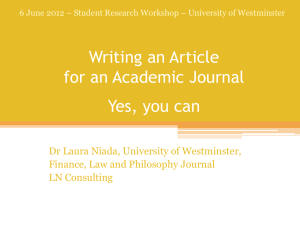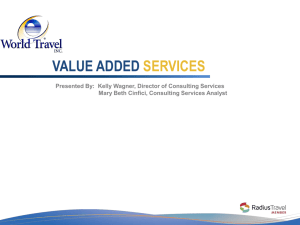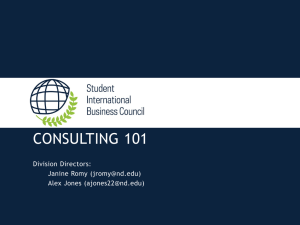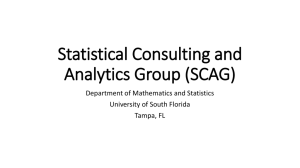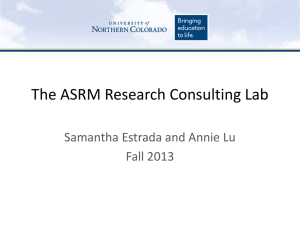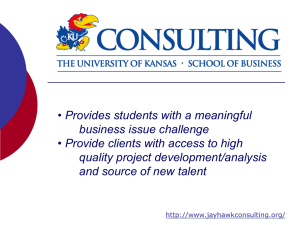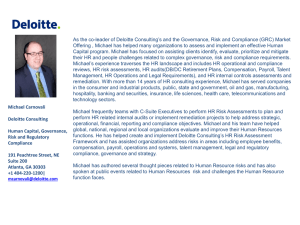PowerPoint - CAUSEweb.org
advertisement
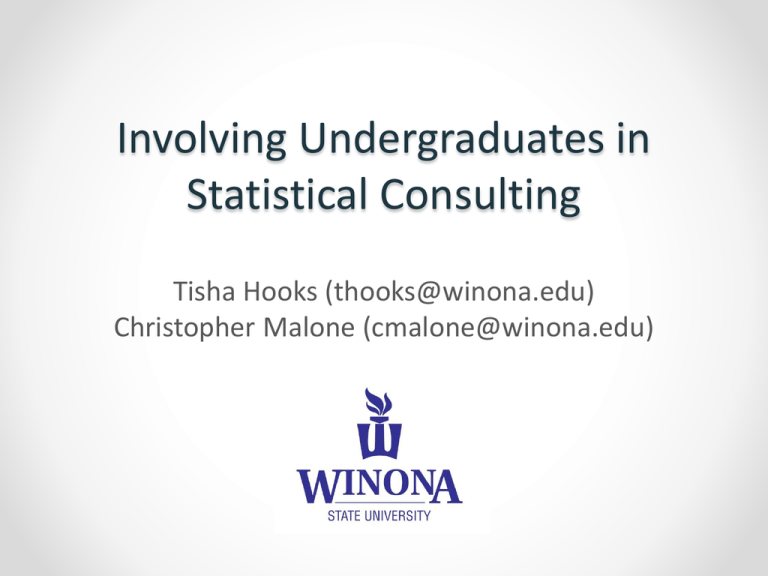
Involving Undergraduates in Statistical Consulting Tisha Hooks (thooks@winona.edu) Christopher Malone (cmalone@winona.edu) Motivation Behind Our Statistical Consulting Model • Winona State is primarily an undergraduate university with an enrollment of approximately 8,000 students • Over the past five years, there has been a substantial increase in both faculty and undergraduate research • The Department of Mathematics and Statistics created the WSU Statistical Consulting Center in 2007 to address the increasing demand for assistance with research projects • The Statistical Consulting and Communication course was first taught in the fall of 2008 with the following objectives in mind — Provide training in statistical consulting — Develop skills in oral communication, written communication, collaboration, and teamwork — Prepare students to staff the consulting center Description of Our Statistical Consulting Model Each academic year, our Statistical Consulting Center is managed by a faculty member who also teaches the consulting course during the fall semester The projects that come in to the center in the fall are handled in the consulting course. Each spring, students who have excelled in the course are hired to staff the center. They are paid $12.50 per hour and work about 5 hours per week. Overview of Our Statistical Consulting Course Who are the students? • Class size is usually 10-15 students • Most students are statistics majors What are the prerequisites? • Any introductory statistics course • Completion of either a regression or design course What are the learning outcomes? • The course will enhance a student’s ability to communicate with both clients and other statisticians • Students develop a personal philosophy of consulting and also become aware of issues statisticians encounter when consulting • Students gain experience in analyzing data and writing summary reports The First Six Weeks – Course Content Discuss the process of consulting • Students become aware of client expectations and the role of a consultant • Students learn qualities of an effective consultant • Students learn how to ask good questions and refine their listening skills Participate in mock consulting sessions • In preparation for meetings with actual clients, students practice with mock clients and receive feedback from this client, the instructor, and their peers • Mock clients are typically past clients of the Consulting Center or other instructors The First Six Weeks – Course Assignments Write reflections on relevant reading assignments • Selected readings from Statistical Consulting… by Janice Derr • “Ethical Guidelines for Statistical Practice” from the ASA • “The Impertinent Questioner…” by Willliam Lurie • “Some General Remarks on Consulting …” by Cuthbert Daniel • “The Practice of Statistics…” by William G. Hunter Interact with experienced statistical consultants • Students interview experienced statistical consultants • If possible, students observe consulting sessions led by other faculty Analyze data, write summaries, and present to mock clients • Course does not focus on analysis of data, but these mock projects allow some time for a brief review of common statistical techniques • Feedback on both oral and written communication skills is essential Course Content for the Remainder of the Semester Meet with actual clients • Internal clients have included individuals from the Department of Biology, Nursing, Business Administration, and Social Work • External clients have included the Minnesota Academy of the Sciences • Clients meet with students during class time, if possible Analyze data, write summaries, and present to clients • Projects are assigned to a team of 2-3 students • Class time is devoted to meeting with clients, discussing projects, briefly reviewing or introducing statistical techniques necessary for each analysis, and working on projects • Students use a variety of software packages • Students choose appropriate methods for analyzing the data and provide both a written report and an oral presentation of the results to the instructor, their peers, and the client Examples of Past Projects Encountered by our Students Measuring the Effect of an Intervention Client: Nursing faculty Comparing Two Teaching Methods Client: Business Admin. faculty Religious Activity and Depression Client: Social Work student • The client had administered a pre/post survey involving 5-point Likert scale outcomes • Students used a paired t-test to analyze the data • Students also researched and implemented Bowker’s test of symmetry to confirm the effect of the intervention • The client had implemented two methods for teaching students how to solve problems in an operations management class • Data consisted of scores on a final assessment and GPA for students from both groups • Consulting students used analysis of covariance and found no significant difference in the two teaching methods • The client collected data from nursing home residents consisting of demographic information and their responses to survey tools measuring depression levels and daily spiritual experiences. • After conducting an exploratory data analysis, students fit statistical models to determine that higher levels of spirituality were connected to lower levels of depression and found some very interesting relationships across gender and religious denomination. Some Challenges Presented by Our Consulting Model Project Management Background Knowledge Demands on Instructor • Demand for statistical consulting fluctuates (too few projects at some times, too many projects at others) • A solution is to solicit a list of suitable projects from clients in advance • Students can successfully handle most projects, but projects should be screened by the instructor • Some projects require advanced techniques (e.g., multivariate analyses or logistic regression) that must be taught to students • A potential solution is to assign these projects to students with a background in these courses (or to exceptional learners) • The instructor of the consulting course serves as Director of the Statistical Consulting Center throughout the year with no reduction in an already heavy teaching load • Documentation of the center’s growth and contributions are important, as this information can be used to pursue release time for the Director over time Advantages of Our Consulting Model Positive Impact on our Curriculum Positive Impact on Students • Our consulting course is well-aligned with the ASA-endorsed curriculum guidelines for undergraduate statistics programs which call us to (1) emphasize real data and authentic applications, (2) encourage synthesis of theory, methods and applications, and (3) offer frequent opportunities to develop communication skills • Our course also addresses Higgins’ call (1999) to “give greater prominence to the important, nonmathematical things we do as statisticians” • All students that successfully complete this course leave with improved skills in data analysis and communication • Students have commented that they enjoy “the application of statistics to help others,” “figuring out what to do with actual raw data,” and “getting experience that is similar to the kind of work I’ll be doing after school” • Exceptional students leave ready to work in our consulting center and gain unparalleled experience as undergraduates References • American Statistical Association. Curriculum Guidelines for Undergraduate Programs in Statistical Science. Retrieved May 6, 2012, from http://www.amstat.org/education/curriculumguidelines.cfm. • American Statistical Association. (1999). Ethical Guidelines for Statistical Practice. Retrieved May 6, 2012, from http://www.amstat.org/about/ethicalguidelines.cfm. • Boomer, KB, Rogness, N., Jersky, B. (2007). Statistical Consulting Courses for Undergraduates: Fortune or Folly? Journal of Statistics Education, 15(3). • Daniel, Cuthbert. (1969). Some General Remarks on Consulting in Statistics. Technometrics, 11(2): 241-245. • Derr, Janice. (2000). Statistical Consulting: A Guide to Effective Communication. Pacific Grove, CA: Brooks/Cole. • Higgins, James. (1999). Nonmathematical Statistics: A New Direction for the Undergraduate Discipline. The American Statistician, 53(1): 1-6. • Hunter, William. (1981). The Practice of Statistics: The Real World Is an Idea Whose Time Has Come. The American Statistician, 35(2): 72-76. • Lurie, William. (1958). The Impertinent Questioner: The Scientist’s Guide to the Statistician’s Mind. American Scientist, 46(1): 57-61.

